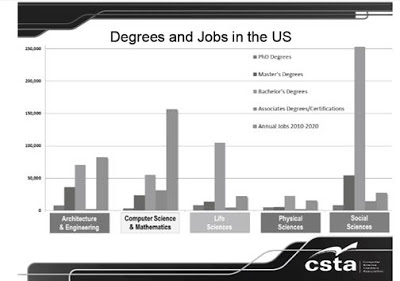SUNDAY, JUNE 9, 2013 Congress, Cool Air and Computer Science for K-5

“If you want to work in an air-conditioned environment, computer science is the way to go.”
I got this advice when I was deciding on an engineering field of study among the many possible choices, Civil, Mechanical, Industrial, etc. It was enticing for someone living in the 120 degrees Fahrenheit scorching heat of Delhi without access to air-conditioning. If that reason was not good enough, computer science held the promise of jobs involving creation of the most cutting-edge technologies. Creating something totally new … now that was quite a motivator.
I decided for computer science and was blessed with opportunities to create many new technologies … from enabling wireless telephony and satellite communications to bringing data to cellphones.
 Two decades later, the potential for exciting jobs still remains. Moreover, “Degrees and Jobs” image (source: CSTA – The National Imperative for K-12 Computer Science Education) below depicts the shortage of Computer Science graduates needed to fill the computing related jobs in the US.
Two decades later, the potential for exciting jobs still remains. Moreover, “Degrees and Jobs” image (source: CSTA – The National Imperative for K-12 Computer Science Education) below depicts the shortage of Computer Science graduates needed to fill the computing related jobs in the US.
Computer science and the technologies that it enables are integral part of our lives today. With digitization, our world, our work environments and our workforce have seen significant transformations.
For our children to be prepared for the 21st century, some foundational computer science skills and knowledge are needed whether or not they eventually decide to pursue a career in computer science. Just like the foundational skills of math and literacy, computer science education needs to start with elementary ages. I have highlighted the need for early STEM exposure in my prior blog, the Big Bang Theory of Early STEM.
Our Congress, demonstrating leadership on this front, is debating on the creation of a STEM Education and Training Account. The stated purposes of this account are (source:http://www.govtrack.us/congress/bills/113/s744):
(i) strengthening STEM education, including in computer science, at all levels;
(ii) ensuring that schools have access to well-trained and effective STEM teachers;
(iii) supporting efforts to strengthen the elementary and secondary curriculum, including efforts to make courses in computer science more broadly available; and
(iv) helping colleges and universities produce more graduates in fields needed by American employers.
Notice that two of the listed purposes specifically mention making computer science available at the elementary level.
We, at STEM For Kids, have been focusing on making STEM fun and real for kids. We are excited about our line-up of innovative STEM programs that include programs in Computer Science:
- Taste of Computer Science
- Critical Thinking and Gaming
- Robotics
- Computers and Communication
- Game Making Lab – coming soon
Through camps and collaboration with different school districts, we are furthering the fun of STEM to K-5 children in and outside schools.
What are your thoughts on making computer science programs accessible for elementary kids?
Follow the discussion further and share your thoughts on BlogSpot, Facebook and Twitter.
By: Moni Singh, Founder and CEO, STEM for Kids, LLC. Mrs. Singh offers a unique perspective on innovation in education through her three lenses: as a mother of elementary age children strongly focused on making STEM fun for kids; as an engineer and a technologist who has brought several technologies to the market, from wireless phones to smart meters; and as a business leader who understands through her work across global organizations that success in the 21st century requires skills in addition to pure technical competence.
One Comment
STEM For Kids
Cialis Prix Bas Viagra Canada Shipping 193 Dth 24 B Kamal Kunj Mumbai India buy viagra Sildenafil Vente 10 Mg Efectos Cialis Viagra Cialis Weniger Nebenwirkungen